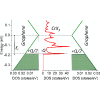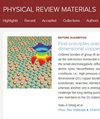Possible Wigner states in CrI3 heterostructures with graphene: A tight-binding model perspective
IF 3.4
3区 材料科学
Q2 MATERIALS SCIENCE, MULTIDISCIPLINARY
引用次数: 0
Abstract
In this study, we present an effective tight-binding model for an accurate description of the lowest energy quadruplet of a conduction band in a ferromagnetic monolayer, tuned to the complementary ab initio density functional theory simulations. This model, based on a minimum number of chromium orbitals, captures a distinctively flat dispersion in those bands but requires taking into account hoppings beyond nearest neighbors, revealing ligand-mediated electron pathways connecting remote chromium sites. Doping of states in the lowest conduction band of requires charge transfer, which, according to recent studies [Tenasini et al., Nano Lett. 22, 6760 (2022); Tseng et al., Nano Lett. 22, 8495 (2022); Cardoso et al., Phys. Rev. B 108, 184423 (2023)], can occur in heterostructures. Here, we use the detailed description of the lowest conduction band in to show that and are type-II heterostructures where light holes in graphene would coexist with heavy electrons in the magnetic layer, where the latter can be characterized by Wigner-Seitz radius (as estimated for hBN-encapsulated structures).

带有石墨烯的 CrI3 异质结构中可能存在的维格纳态:紧束缚模型视角
在这项研究中,我们提出了一种有效的紧密结合模型,用于准确描述铁磁性 CrX3 单层中导带的最低能量四元组,并根据互补的 ab initio 密度泛函理论模拟进行了调整。该模型以最低数量的铬轨道为基础,捕捉到了这些带中明显平坦的色散,但需要考虑近邻之外的跳变,揭示了配体介导的连接偏远铬位点的电子路径。CrX3 最低导带中的掺杂态需要电荷转移,根据最近的研究[Tenasini 等人,Nano Lett.在这里,我们利用对 CrI3 最低导带的详细描述来说明 G/CrI3/G 和 G/CrI3 是 II 型异质结构,其中石墨烯中的轻空穴将与磁层中的重电子共存,后者可以用 Wigner-Seitz 半径 rs∼25-35 来描述(根据对 hBN 封装结构的估计)。
本文章由计算机程序翻译,如有差异,请以英文原文为准。
求助全文
约1分钟内获得全文
求助全文
来源期刊

Physical Review Materials
Physics and Astronomy-Physics and Astronomy (miscellaneous)
CiteScore
5.80
自引率
5.90%
发文量
611
期刊介绍:
Physical Review Materials is a new broad-scope international journal for the multidisciplinary community engaged in research on materials. It is intended to fill a gap in the family of existing Physical Review journals that publish materials research. This field has grown rapidly in recent years and is increasingly being carried out in a way that transcends conventional subject boundaries. The journal was created to provide a common publication and reference source to the expanding community of physicists, materials scientists, chemists, engineers, and researchers in related disciplines that carry out high-quality original research in materials. It will share the same commitment to the high quality expected of all APS publications.
 求助内容:
求助内容: 应助结果提醒方式:
应助结果提醒方式:


